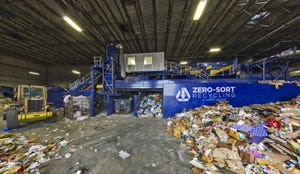Takeaways from Day One at WASTECON 2017
The Solid Waste Association of North America’s (SWANA) largest event, WASTECON, began on Monday in Baltimore.

The Solid Waste Association of North America’s (SWANA) largest event, WASTECON, began on Monday in Baltimore.
The conference kicked off with an opening ceremony, hosted by SWANA President Richard Allen and International Solid Waste Association (ISWA) President Antonis Mavropoulos. Attendees then headed to the exhibition hall and various education sessions, which covered climate change, circular economy, closing dumpsites, energy recovery, marine litter, resource management, safety, smart technologies, waste management challenges and more.
Here are some key takeaways from the first day of WASTECON:
"We are very pleased with the diverse audience that is attending WASTECON and the ISWA WORLD Congress in Baltimore,” says David Biderman, CEO and executive director of SWANA. “We had more than 1,000 people at the opening ceremony. It was extraordinary. In addition, we have had very strong attendance at our climate change keynote and the CEO panel. It's going to be a very exciting week."
During the a CEO roundtable keynote session, Jim Fish of Waste Management, Stephen Jones of Covanta, Sergio Pedreiro of Estre Ambiental and Chen Xiaoping of China Everbright International discussed current trends in the industry and some of the new things their companies are doing.
When asked if they would do anything differently, Fish stated that he would have had a better education program when recycling first started. “Years later, my own children aren’t even sure what can and cannot be recycled.”
Fish also claimed that “while we have been good at driving material into single stream plants, we have also been good at driving a lot of trash into those plants. The more trash that goes into the waste stream, the more consumers pay.”
Closing out his comments, Fish shared that Waste Management is looking at technology to see how it can create the next generation of landfills and improve recycling and collection.
Jones stated that the biggest issue with a waste-to-energy (WTE) plant is that whatever is thrown out in the morning is trying to be combusted in the afternoon.
From a WTE standpoint, recycling metals is a big part of what Covanta does. “If we had a do-over, we would set up these plants to focus more on metals,” comments Jones.
Covanta recently started operations at its new Dublin, Ireland WTE facility, and it’s exploring other international operation opportunities. “In the immediate future, you will see some expansions from us inside the U.S., but most of our new energy-from-waste facilities will be built outside of the U.S.,” says Jones.
In both China and Brazil, about two percent of materials are recycled.
In terms of enforcing environmental requirements and regulations, Brazil’s efforts are very similar to the United States’, according to Pedreiro.
In the Smart Cities: The Data-Driven Evolution of Waste Management session, Nate Morris of Rubicon Global and Marianne Blanc of SUEZ North America spoke about their partnership and how cloud-based waste and recycling solutions are bringing greater operational efficiency and smoother stewardship.
Morris stated that “it’s not about disrupting the industry; it’s about working with each other to evolve and make the industry better.”
Morris also said that “he believes that the future is about digitalization.”
Morris also shared that governments are embracing the smart cities movement, integrating data and technology to drive efficiency and respond to citizen demands and improve the quality of life.
Blanc highlighted the major ongoing transformations in the waste and recycling industry:
A highly competitive market where client and flows ownership are key.
More mono-flows, driven by regulation (taxes and sorting at the source department).
Development of local loops for reuse, recycling and recovery.
Both public and private clients becoming more mature, with higher expectations, especially on prevention, recycling and recovery, and putting pressure on prices.
Recycling business in development, even though exposure to commodities and the lack of incentives impact the business model in the short term.
Good perspectives for energy recovery, despite energy prices instability.
Prices exposed to commodities volatility and capacity effects.
Digital platforms blooming, with many small, pure digital players, more agile and customers centric.
“Our history is based on landfills, but we believe the future is in both material and energy recovery,” says Blanc.
In the Circular Economy Showcase session, John Bradburn of General Motors (GM) and Nelson Switzer of Nestle Waters North America discussed how their companies are closing the loop.
Bradburn provided an overview of GM’s sustainability goals:
All manufacturing sites will have a wildlife habitat certification or equivalent (where feasible).
GM will utilize 125 MW of renewable energy sources.
Reduce energy intensity by 20 percent (baseline 2010).
Reduce total waste by 40 percent (baseline 2010).
Reduce carbon intensity by 20 percent (baseline 2010).
Reduce water intensity by 15 percent (baseline 2010).
Reduce VOC intensity by 10 percent (baseline 2010).
100 manufacturing and 50 non-manufacturing sites are landfill free.
Bardburn also shared that sustainable materials management is an umbrella program for design for the environment, global by-product management, beneficial use process, circular economy and landfill free.
“Our greatest sustainability challenge is global turbulence,” says Bradburn. “And when things like natural disasters, terrorism, crime, poverty, disease and hunger are resolved then it will be a day that sustains the next.”
General Motors recycles about 2.5 million tons of material per year.
Switzer stated that as an industry, “we are moving from a linear economy to one where all products are consumed, recovered and reused.”
He also said that $11.4 billion is the estimated total value of commodities unrecovered in the U.S., less than 55 percent of households have access to single stream systems, the U.S. recycling rate is 31 percent and only 22 percent of PET is recovered in the U.S.
In the last keynote session of the day, Smart Technologies and Their Impact on Collection and Transportation of Waste, Antonis Mavropoulous of ISWA, Jason Gates of Compology, Don Diego Padilla of FleetMind, Vivek Agrawal of Kanak Resources Management Limited and Centre for Development Communication and Marc Rogoff of SCS Engineers spoke about how smart technologies and the Internet of Things do or could impact the collection and transportation of waste.
Padilla stated that “we are slow to change as an industry. The only way to get better is with business intelligence, and the only way to get business intelligence is through technology.”
He also said that “people have to learn how to use big data. It may not be hard to get big data, but it’s challenging to learn how to use big data.”
Instead of highlighting big data, Gates shared that providing small data or the right data can have tremendous impact.
About the Author
You May Also Like




